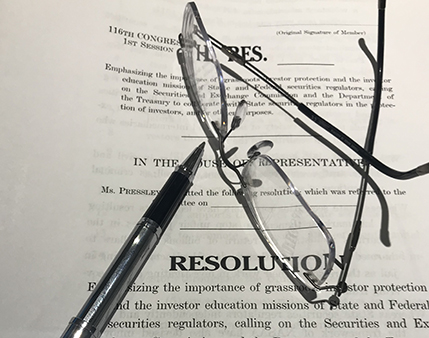Written Statement of Denise Voigt Crawford
President, North American Securities Administrators’ Association, Inc.
Commissioner, Texas Securities Board
Submitted to the Finance and Hazardous Materials Subcommittee
U.S. House of Representatives
September 29, 1998
Mr. Chairman and Members of the Subcommittee:
I appreciate the opportunity to submit a written statement on behalf of the North American Securities Administrators Association (“NASAA”)1 for the record of this hearing on the impact of mutual fund fees. I have previously testified before the Finance and Hazardous Materials Subcommittee on other investor protection-related issues, and I am pleased you are addressing the issue of mutual fund fee disclosure among other things.
Throughout the 105th Congress, you have directed public and industry attention to such investor issues as decimalization, on-line trading, and SOES trading. NASAA is most appreciative of your efforts.
In July of this year, NASAA participated in and coordinated a panel on mutual fund fees with the National Press Club, which was widely covered by the mainstream media. The participants, who included the Securities and Exchange Commission (“SEC”), Vanguard Group, American Association of Retired Persons, and Kiplinger’s magazine, helped raise awareness of the importance of fees. These panelists agreed: Investors simply haven’t focused on fees during the bull market and they may be in for a rude awakening.
Millions of American investors could be overpaying for their mutual funds because they simply don’t understand how much fees are costing them. Comparison shopping — something we routinely do for cereal, computers and cars — is hard to do with mutual funds because of the confusing fees and generally inadequate disclosure. The Securities and Exchange Commission’s recently adopted rules should prove helpful to investors seeking to understand the impact of fees and other costs.
The past few years have shown phenomenal growth in the mutual fund industry — so much growth and success that many new investors are entering the market with extremely high expectations. One survey found that investors expect at least a 22.3 percent annual return for the next ten years2. What if these expectations aren’t achieved?
The Investment Company Institute (“ICI”) has estimated that 65 million Americans now invest in more than 6,800 mutual funds. Total mutual fund assets recently surpassed $5 trillion versus $1 trillion in 1990.
A great number of these investors have switched from savings plans with insured bank products to investments in mutual funds, which carry the additional risk of loss of principal. In addition, these new investors are largely ignorant of the risks and costs of mutual fund investing. This continuing ignorance is an unacceptable situation.
In a speech before the ICI in May, Securities and Exchange Commission Chairman Arthur Levitt stated: “Only 8 percent say they [mutual fund investors] completely understand the expenses that their funds charge.” And, Levitt said, “less than half of these people know that fund expenses are deducted on an ongoing basis.”
In fact, the Dow Jones News Service reported in July: “In an SEC survey of 2,000 investors, just one out of five could estimate expenses for their largest mutual fund holding, and only one in six understood that higher fees lower investment returns.”3
The SEC requires that mutual fund companies show a fee table at the beginning of their prospectus that outlines their total expenses. The industry’s tables, however, do not always show or explain costs clearly, which can inhibit an investor’s ability to gauge the fund expenses without reading further into a lengthy prospectus.
In order to understand the prospectus, investors must comprehend the myriad variety of complex expenses. Expenses such as front-end and back-end loads and operating expenses have costs that are not always fully explained in the table.
One fee that has confused investors and received some media attention is the 12b-1 fee. This fee is often a commission for salesperson activities, but can also be applied to defer the costs of advertising and marketing materials4. Any change that gives investors a better idea of the type of costs included in 12b-1’s would be an improvement.
In addition to clearing up the confusion surrounding fee definitions, long-term costs of a mutual fund could also stand some clarification. SEC Chairman Levitt stated in May that “a fee of 1 percent would reduce an investor’s final account balance by 17 percent on an investment held for 20 years.” Most prospectuses don’t give you this kind of important information.
This is exactly why investors need to understand fees — so they may accurately compare funds and be prepared for market fluctuations. Understanding the full cost of a fund’s expenses, especially with the high volume of investors investing over the Internet, is essential to being able to make sound investment decisions. NASAA believes that the true effects of costs need to be disclosed.
As you may be aware, the SEC has been actively pursuing changes to mutual fund disclosure rules and, in particular, fee disclosures. In March of 1998, the SEC Rule 498 and amendments to the N-1A form were adopted. NASAA applauds the changes to the fee table disclosure, which clear up potentially confusing definitions such as the redemption fee.
In addition, NASAA believes that the changes to form N-1A such as showing the effects of fund costs by using the example of $10K instead of just $1K, will help investors grasp the long-run effects of total fund expenses.
At the same time, the SEC has adopted “Plain English Rules,” which will reduce legal and financial jargon — another aid for investors.
I am also pleased that the mutual fund industry has been supportive of the SEC’s fee disclosure initiatives, and I strongly urge the industry to quickly adopt these new rules and follow them explicitly.
In conclusion, NASAA believes the changes to the SEC rules will help investors make better-informed decisions. But more needs to be done through investor education to prepare Americans to take greater responsibility for their financial futures.
Chairman Oxley, and Members of the Subcommittee, NASAA commends you for your important work in this area. Thank you for allowing me to submit this statement, and I welcome the opportunity to work with you on better informing our nation’s investors on mutual fund fees and on other securities-related issues.
Endnotes:
1The oldest international organization devoted to investor protection, the North American Securities Administrators Association, Inc., was organized in 1919. Its membership consists of the 65 state, provincial and territorial administrators in the 50 states, the District of Columbia, Canada, Mexico and Puerto Rico. In the U.S., NASAA is the voice of the 50 state securities agencies responsible for grass-roots investor protection and efficient capital formation.
2The Montgomery “Wise Investor” Survey, 3rd Quarter 1997.
3Dow Jones News Wire Service, “SEC To Take ‘Wait-And-See’ Approach To Mutual Fund Fees,” July 1, 1998.
4Securities and Exchange Commission: “Invest Wisely, An Introduction to Mutual Funds.”
September 29, 1998












